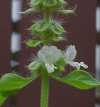208 — Number of the plant
at the book: The Mother. The Spiritual Significance of Flowers.- 1-st Ed. / Sri Aurobindo Ashram Trust, Pondicherry (India).- Singapore: Ho Printing, 2000.- ISBN 81-7058-609-7
Classification
► Division Magnoliophyta - Flowering plants
► Class Magnoliopsida - Dicotyledons
► Subclass Asteridae
► Order Lamiales
► Family Lamiaceae [= Labiatae] - Mint family
► Subfamily Nepetoideae
► Tribe Ocimeae
► Genus Ocimum L. - Basil
Synonyms
Ocimum americanum Jacq.
Ocimum barrelieri Roth
Ocimum basilicum var. glabratum Benth.
Ocimum basilicum var. majus Benth.
Ocimum bullatum Lam.
Ocimum thyrsiflorum L.
Plectranthus barrelieri (Roth) Spreng.
Common names
Basil (English)
Basilie (English)
Common basil (English)
Garden basil (English)
Roman basil (English)
Sweet basil (English)
Basilic (French)
Herbe royale (French)
Oranger des savetiers (French)
Pistou (French)
Bosiljak (Croatian)
Bazalka pravá (Czech)
Basilik (Danish)
Basilikum (Danish)
Baziel (Dutch)
Bazielkruid (Dutch)
Koningskruid (Dutch)
Basilika (Finnish)
Basilienkraut (German)
Basilikum (German)
Echtes Basilienkraut (German)
Gartenhirnkraut (German)
Gewöhnliches Basilienkraut (German)
Königskraut (German)
Vasiliko (Greek)
Vasilikos (Greek)
Basilico (Italian)
Basilikum (Norwegian)
Basylico (Polish)
Basílico (Portuguese)
Hierba de vaquero (Portuguese)
Manjerico (Portuguese)
Базилик (Russian)
Базилик обыкновенный (Russian)
Базилик овощной (Russian)
Душистые васильки (Russian)
Bosiljak (Serbian)
Bosilje (Serbian)
Bosiok (Serbian)
Faslidjan (Serbian)
Maslidjan (Serbian)
Bazalka pravá (Slovak)
Bazalky pravej (Slovak)
Bazilika (Slovenian)
Albahaca (Spanish)
Albahaca común (Spanish)
Albahaca silvestre (Spanish)
Alhábega (Spanish)
Ocimo (Spanish)
Basilica (Swedish)
Alrihan (Arabic)
Háabaq nabatái (Arabic)
Habaq (Arabic)
Rihan (Egypt (Arabic))
Rehan (Hebrew)
Deban-shab (Persian)
Firanj mushk (Persian)
Rayáahn (Persian)
Reyhan (Persian)
Feslien (Turkish)
Babuitulsi (India (Bengali))
Baburi tulsi (India (Bengali))
Debunsha (India (Bengali))
Khubkalam (India (Bengali))
Damaro (India (Gujarati))
Damro (India (Gujarati))
Nasabo (India (Gujarati))
Sabje (India (Gujarati))
Babui tulsi (India (Hindi))
Babul (India (Hindi))
Bahari (India (Hindi))
Barbar (India (Hindi))
Kali tulsi (India (Hindi))
Ram Tulsi (India (Hindi))
Rihan (India (Hindi))
Sabzah (India (Hindi))
Kama kasturi (India (Kannada))
Kamkusturi (India (Kannada))
Ramkasturi (India (Kannada))
Sajjebiya (India (Kannada))
Tulasigidda (India (Kannada))
Paccha (India (Malayalam))
Truinitru (India (Malayalam))
Sabza (India (Marathi))
Dhalatulasi (India (Oriya))
Ajaganothika (India (Sanskrit))
Arjaka (India (Sanskrit))
Barbari (India (Sanskrit))
Manjarika (India (Sanskrit))
Munjariki (India (Sanskrit))
Surabhi (India (Sanskrit))
Tulasidevesha (India (Sanskrit))
Tungi (India (Sanskrit))
Capja (India (Tamil))
Sabja (India (Tamil))
Sada tulasi (India (Tamil))
Tirnirupachai (India (Tamil))
Tirunirrippachai (India (Tamil))
Tirunirruppaccai (India (Tamil))
Tirunitru (India (Tamil))
Tirunittru (India (Tamil))
Tirunutpatchi (India (Tamil))
Tiviragandam (India (Tamil))
Bhutulasi (India (Telugu))
Rudrajada (India (Telugu))
Rihan (India (Urdu))
Bāvarī phūl (Nepalese)
Tulasī (Nepalese)
Hintala (Sinhalese)
Sawandalata (Sinhalese)
Suwandutala (Sinhalese)
Pinsein (Burmese)
Ziya apyu (Burmese)
Daun kemangi (Indonesia (Malay))
Tulasiya sasyajati (Khmer)
Phak bua la pha (Laotian)
Phak bua la phe (Laotian)
Phak i tou (Laotian)
Kemangi (Malay)
Ruku-ruku (Malay)
Selasih hijau (Malay)
Horapha (Thai)
Luo le (Chinese)
Bajiru (Japanese)
Mebouki (Japanese)
Suiito bajiru (Japanese)
Basilie (Afrikaans)
Basilikum (Afrikaans)
Mrihani (Swahili)
Framboisin (Antilles (Fench))
Alfavaca-cheirosa (Brazil (Portuguese))
Alfavacão (Brazil (Portuguese))
Manjericão (Brazil (Portuguese))
Manjericão-graúdo (Brazil (Portuguese))
Description
Tiny white bilabiate flowers lightly tinged pink with green leaves and a greenish purple calyx and stem, the latter becoming entirely purple towards the tip of the raceme. A shrubby annual or perennial culinary herb with aromatic leaves.
Without character, without some kind of high or strong discipline there is no enduring power of life.
Sri Aurobindo. Sri Aurobindo Birth Centenary Library in 30 Volumes. - Volume 15. - Social and political thought
Discipline is indispensable to progress. It is only when one imposes a rigorous and enlightened discipline on oneself that one can be free from the discipline of others.
The supreme discipline is integral surrender to the Divine and to allow nothing else either in one's feelings or in one's activities. Nothing should ever be omitted from this surrender - that is the supreme and most rigorous discipline.
The Mother. Collected Works of the Mother.- Volume 12. - On Education
Any discipline that is followed rigorously, sincerely, deliberately, is a considerable help, for it enables life on earth to attain its goal more rapidly and prepares it to receive the new life. To discipline oneself is to hasten the arrival of this new life and the contact with the supramental reality.
The Mother. Collected Works of the Mother.- Volume 10. - The Thoughts and Aphorismes
No life can be successful without self-discipline.
The Mother. Collected Works of the Mother.- Volume 14. - Words of the Mother







